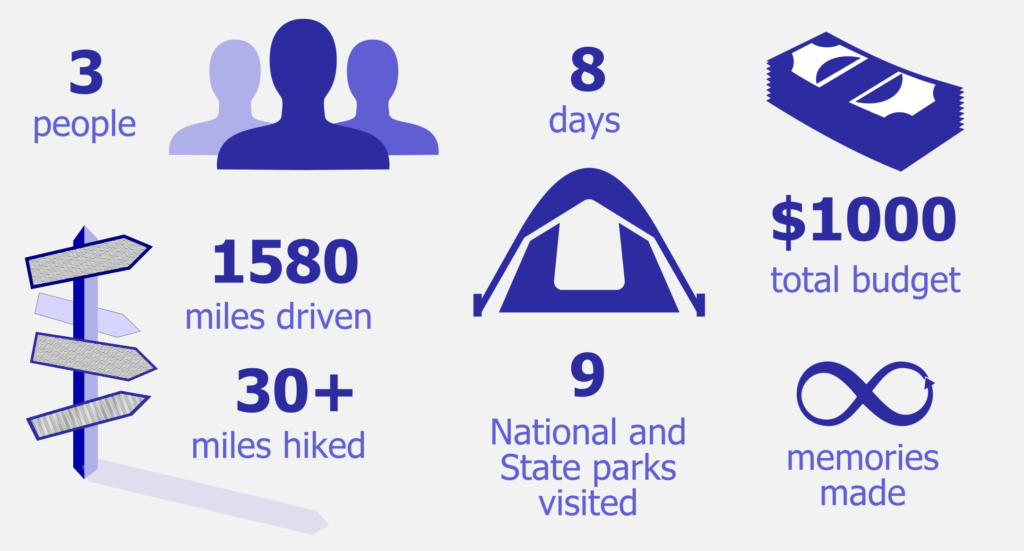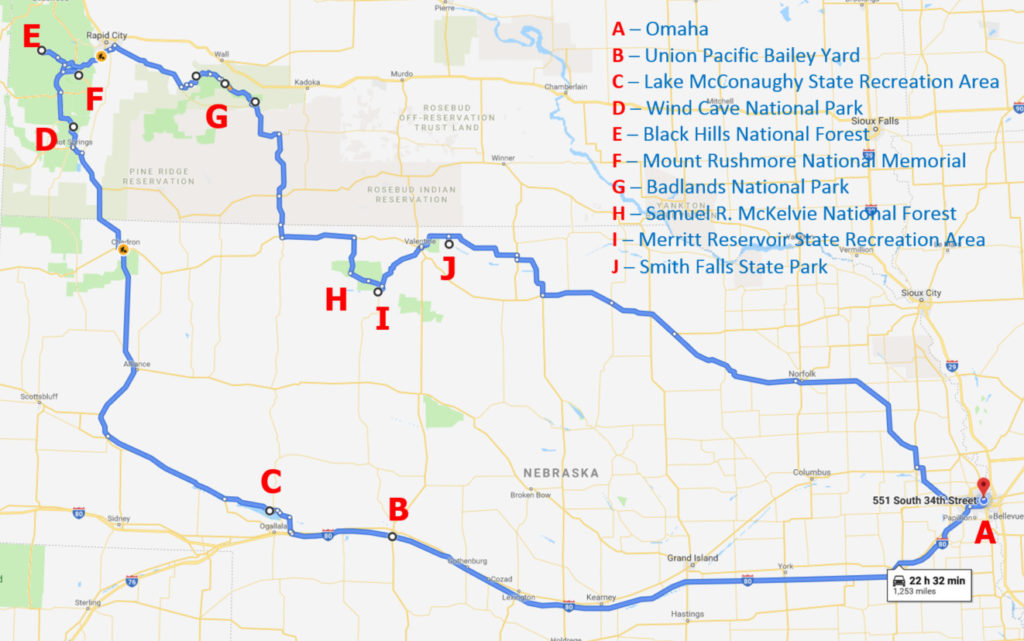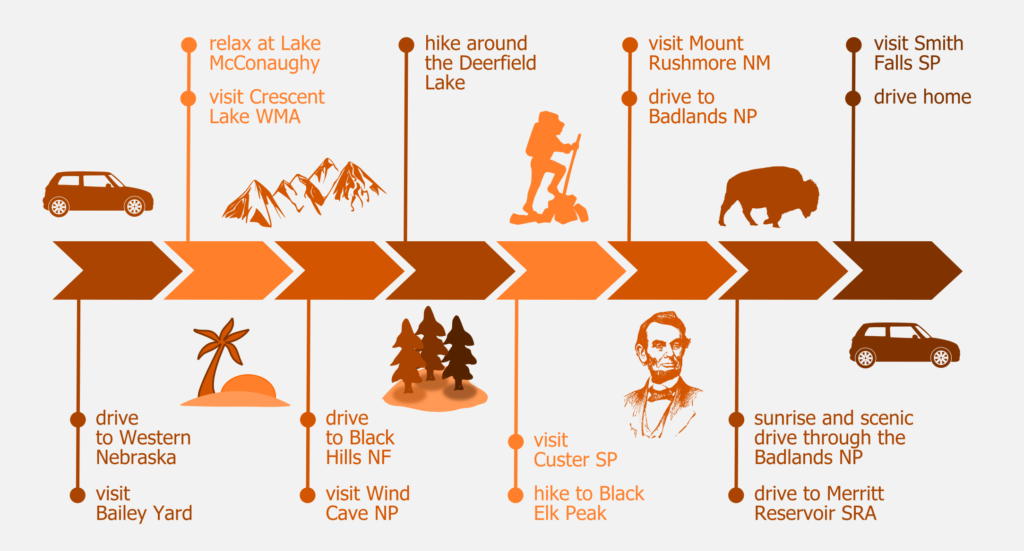Read about the entire trip:
In a nutshell
Our trip through Nebraska to the Black Hills and Badlands of South Dakota is in the books, and this summary concludes a series of posts taking us back to those amazing eight days. Planning a successful road trip takes a lot of time and requires attention to fine details, thus I thought it would be a good idea to take you behind the scenes of this trip and share our planning, results, and lessons learned.

Overall, we spent 8 days on the road in the middle of June. We drove almost 1600 miles, visited 9 National and State parks (forests, memorials and recreation areas included). We camped in four of them, and covered over 30 miles during our scenic hikes. Overall we spent a little less than $1000 (“all inclusive” for 3 people), with an estimated cost of the entire trip of slightly over $350 per person.
The route
The ultimate goal of the trip from the beginning was visiting the Black Hills National Forest. When planning road trips, I like design the loop routes, thus maximizing the variety of places that we can see, while covering the same distance on the road. I also try to avoid excessively dense and stressful schedules. It is vacation in the very end, which means it is important to balance rest and relaxation with the desire to see and do as much as possible.

After reading some more about the Badlands National Park, we expanded our stay there and decided to spend a night in the campground right next to the park. The drive to our destination and back were long enough to warrant overnight stops with some hiking and sightseeing on the way. The resulting final route is presented on the map above.
The schedule
The schedule was finalized in early spring. Soon after that I made reservations for all campgrounds except Merritt Reservoir (our last stop on the way back home). That stop was planned for Friday night, and Nebraska parks require two nights minimum stay for advance reservations on weekends. Thus, we already had at least one unknown in our trip’s equation.
The first day involved mostly driving from Omaha to our first camping location – Lake McConaughy State Recreation Area in Western Nebraska. We stopped at the Union Pacific’s Bailey Yard on our way there. We spent Day 2 at the lake and around, having some rest after the day on the road. Day 3 had another long drive in store – but the reward was visiting the Wind Cave National Park, and eventually arriving to one of the most beautiful campgrounds I’ve ever stayed at, in the Black Hills National Forest.

Main adventure of the Day 4 was the longest (14+ mile) hike of the trip – around the Deerfield lake where we set our camp for 3 nights. Without much break, another big hike was planned for the Day 5: this time we ventured to the top of South Dakota – the Black Elk Peak.
We had to leave the Black Hills on the Day 6, only to find ourselves in a completely different, but not less impressive scenery of the Badlands National Park. On our way east, we made a quick stop at one of the most iconic parks of the United States – Mount Rushmore National Memorial. We spent first half of the Day 7 at the Badlands (however it felt much longer, as our day started before sunrise). We then continued with the first leg of our drive home. After a night at the Merritt Reservoir State Recreation Area, our final Day 8 started with a visit to the Smith Falls State Park, and then continued with a six-hour drive back to Omaha.
In terms of daily schedule, we usually planned a quick but hearty breakfast prepared on a camping stove (no time for campfire!). Then we continued on with the plans for the day. If we went on a hike, we usually packed sandwiches for lunch. On the “drive days” we stopped for lunch somewhere on our way. Evenings in the camp, of course, meant time around the campfire, grilling some meat, and relaxing with a cup of tea and excessive amounts of s’mores 🙂
The money
From the financial standpoint, I like to plan my trips on an “economy” budget. However, I like a good balance between price and benefits, and always try to maximize the value of every trip.
When it comes to accommodation, tent camping is the best way to optimize the cost. In addition to that, it offers an experience of a lifetime – away from civilization and connecting with Nature. Food was the major part of our expenses, and made almost half of the overall budget of the trip. We minimized eating out by planning all meals ahead, and mostly followed our schedule. This also helped to avoid buying too much extra food, or last-minute unplanned visits to local stores where prices will be higher than at home. We did make a planned stop at Walmart approximately in the middle of the trip to refill with fruits, vegetables, water and ice.

We had to pay park fees in South Dakota – however, we were able to save on this item in Nebraska as I have the annual pass for all State Parks. Other expenses mostly included firewood purchases that we made locally. One of the items that we had almost no chances to optimize was gas – however, I was satisfied with my car’s mileage, and we ended up spending less than I initially budgeted.
Overall the cost of the trip came up to a little bit over $350 per person (or ~$40/day), which is a great result for how much we got for this amount of money!
Lessons learned
Every such trip is not only a great time exploring new places, but also a valuable learning experience. It is also time to feel satisfied for something that you did right – little victories are important! Here are some hints that will help you better plan your next trip:
- In order to maximize the value and spend your time most efficiently, you have to plan such trips in advance. However, you can’t predict weather that far ahead. Thus, be prepared and have a “plan B” for a rainy day, so that alterations in your schedule don’t ruin your positive experience from the trip.
- Give yourself enough time to set up the camp when you arrive to a new campsite. Ideally – arrive a few hours before it gets dark. It is particularly valuable if you don’t have a reservation.
- In many locations weather changes significantly during the day, and temperatures vary at daytime and at night. It is particularly true in spring and fall. The best strategy is to have at least 3-4 layers that you can put on and take off. Have good rain gear and extra warm clothes just in case – especially if you venture out for longer than just a weekend.
It was a great experience – from the very first planning steps to the culmination of the trip in June, to hours at the keyboard writing these series and living this amazing week in my memories again. I have several routes in my mind for our next trip, and can’t wait for an opportunity to bring these ideas to life!